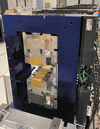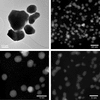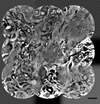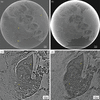issue contents
March 2023 issue

Cover illustration: Synchrotron microprobe X-ray fluorescence imaging is generally considered to be semi-quantitative; however, the technique can be performed quantitatively for some elements in rice grain thin sections (see Limmer, Webb and Seyfferth, pages 407–416).
facility information
research papers
Open  access
access
 access
accessTwo modulators have been designed, assembled, magnetically tested and installed at SwissFEL in order to implement laser-based seeding at the soft X-ray beamline Athos.
Open  access
access
 access
accessA beam-splitting off-axis zone plate setup to measure transient X-ray absorption spectroscopy is presented, as implemented at the Spectroscopy and Coherent Scattering instrument at the European X-ray Free-Electron Laser.
Open  access
access
 access
accessAn insertion device capable of switching the operation mode between helical and figure-8 undulators has been developed.
Open  access
access
 access
accessWith the performance of synchrotron radiation sources increasing significantly, higher requirements have been placed on the stability of double-crystal monochromators (DCMs). Using traditional passive vibration control techniques, such as optimized structures, elastic damping and vibration-absorbing materials, is unlikely to meet the future requirements of DCMs. The proposed method is the first attempt of an adaptive filtering algorithm based on variational modal decomposition in the field of DCMs development, which is an advancement for the development of high-performance DCMs at synchrotron radiation facilities.
Open  access
access
 access
accessThe effects of zone materials and zone shapes on the focusing/imaging quality of dielectric kinoform zone plates have been theoretically investigated by a modified thin-grating-approximation method. Greyscale electron beam lithography was applied to generate 3D kinoform zones in HSQ and PMMA for soft X-rays. The dielectric kinoform zone plate lens demonstrates high diffraction efficiency well beyond conventional X-ray optics.
Open  access
access
 access
accessTotal scattering data can be obtained on the PD beamline although there are constraints to the capabilities offered including longer acquisition times and necessary dilution of highly absorbing samples. This work details the considerations needed to successfully carry out total scattering studies on this bending-magnet beamline, which has not been specifically designed for total scattering experiments.
Open  access
access
 access
accessA novel bifunctional in situ Fourier transform infrared (FTIR) cell has been elaborately designed and prepared. By coupling with single-reflection infrared mode, a facile and general in situ synchrotron FTIR spectroscopic method has been developed based on the FTIR cell for surface dynamic studies of electrodes during electrolysis.
Open  access
access
 access
accessA novel microfluidic rotating-target device capable of three-degrees-of-freedom motion has been proposed, and its feasibility for sample delivery was successfully verified at a synchrotron radiation facility. This device guarantees the full utilization of crystals and only 0.1 mg of protein is consumed in collecting a complete dataset.
Open  access
access
 access
accessThe effects of synchrotron-based kilovoltage X-rays on a cell's morphology and motility are investigated.
Open  access
access
 access
accessIn this work, serial X-ray fluorescence holography is developed and its capabilities are demonstrated by obtaining hologram patterns from the protein crystal Photosystem II before any signs of radiation-induced damage. This new technique paves the way for future experiments on protein crystals that aim to clarify the local atomic structure of their functional metal clusters.
Open  access
access
 access
accessIn situ diffraction contrast tomography has been deployed at the Psiché beamline of Soleil. The evolution of lattice rotation in a 2000 grain region of a titanium sample under tension is studied.
Open  access
access
 access
accessA direct photon-counting detector was used for different nanoimaging phase contrast techniques, increasing the temporal resolution.
Open  access
access
 access
accessThe development of synchrotron-radiation-based high-energy X-ray micro-laminography to visualize microstructures in dense planar objects such as planar fossils is described.
Open  access
access
 access
accessThis work demonstrates which elements are the most easily quantifiable by synchrotron radiation for microprobe X-ray fluorescence (SR-µXRF) imaging in order to understand elemental distributions in plant tissues, with a focus on metals and metalloids in rice grain. This work provides SR-µXRF users with data to understand which elements can be reliably quantified and guidance on how to consider the limitations of the technique to most effectively interpret such data.
Open  access
access
 access
accessThis work shows that combining helical acquisition mode with synchrotron radiation propagation-based imaging computed tomography is a powerful tool for tissue engineering applications with image qualities of high contrast, low noise level and, most importantly, fewer ring artifacts.
Open  access
access
 access
accessThis article outlines the procedure for performing synchrotron radiation based dynamic micro-computed tomography of wet granulation of pharmaceutical powders and subsequent methods for quantitative analysis.
short communications
Open  access
access
 access
accessWith the increased brilliance at the European Research Facility–Extremely Brilliant Source (ESRF–EBS), a beam-induced reduction of non-stochiometric iron oxide nanoparticles (almost maghemite composition) to magnetite was observed in a mixture of ethanol and water with low ethanol concentration.
Open  access
access
 access
accessA method to determine the 3D position of particles in Bragg coherent diffractive imaging experiments is proposed. Test measurements demonstrate depth-resolution with a precision of 20 µm along the beam.
beamlines
Open  access
access
 access
accessThe feasibility of X-ray absorption fine-structure (XAFS) experiments of ultra-dilute metalloprotein solutions at Indus-2 is evaluated.
Open  access
access
 access
accessThe soft X-ray beam from the SASE3 source at the European XFEL is delivered to the SQS instrument by a beam transport system. The system layout and performances are reported.
Open  access
access
 access
accessThe design and performance of a new dedicated spectromicroscopy beamline at the Swedish national synchrotron (MAX IV) is presented.
Open  access
access
 access
accessThe properties of the recently installed split-and-delay unit at beamlines FL23 and FL24 at FLASH2 are presented. Its operational range, performance parameters and results of a first experiment are described.
Open  access
access
 access
accessFor irreversible or slow reactions studies by time-resolved pump–probe X-ray solution scattering, the standard sample cell and protocol for data collection at the BioCARS 14-ID beamline potentially require up to hundreds of milligrams of sample. A sheath co-flow cell, described here, allows such solution scattering measurements to be conducted with the sample consumption reduced by more than ten times compared with standard protocols at this beamline.

 journal menu
journal menu











































